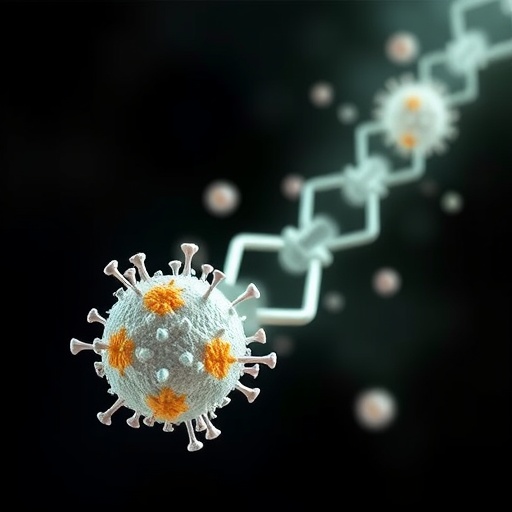In a groundbreaking study that blurs the lines between nanotechnology and cancer therapeutics, researchers have developed an innovative fusion nanoparticle system designed to enhance the efficacy of anticancer drugs. This emerging strategy involves the combination of extracellular vesicles (EVs) and docetaxel-loaded liposomes, a novel approach that promises to transform the landscape of cancer treatment. The study, conducted by a team of experts in pharmaceutical investigations, sets the stage for more targeted and effective therapies, showcasing the potential of nanocarriers in combating one of humanity’s most relentless adversaries: cancer.
The importance of effective drug delivery in oncology cannot be overstated. Conventional chemotherapy often suffers from significant drawbacks, including severe side effects and suboptimal distribution of medications to cancer cells. This new approach addresses these challenges head-on, utilizing the natural properties of extracellular vesicles alongside synthetic liposomal systems. By merging these two powerful delivery methods, researchers believe they are on the brink of a new era in cancer care that could lead to better patient outcomes and fewer adverse effects.
Extracellular vesicles are small membrane-bound structures that play crucial roles in intercellular communication. They naturally transport proteins, lipids, and genetic material between cells, making them ideal candidates for drug delivery systems. Their biocompatibility and ability to evade the immune system enhance their appeal, especially in the context of cancer therapy where targeting tumors while minimizing damage to healthy tissues is paramount. By loading these vesicles with chemotherapeutic agents like docetaxel, researchers can harness their potential for more localized and efficient drug delivery.
Docetaxel, a widely used chemotherapy drug, is known for its effectiveness in treating various types of cancer, including breast and lung cancer. However, its clinical use is often hampered by systemic toxicity and resistance. The integration of docetaxel into liposomes—spherical vesicles made of phospholipids—can significantly improve its pharmacokinetics and biodistribution. The liposomal formulation allows for controlled release of the drug, which can enhance the therapeutic index while minimizing side effects. The combination of docetaxel-loaded liposomes with EVs not only provides a dual mechanism of delivery but also enhances the overall treatment efficacy.
The fusion of these two powerful systems offers multiple advantages. The hybrid approach enables the nanoparticles to leverage the targeting capabilities of EVs while simultaneously benefiting from the prolonged circulation times associated with liposomes. This synergy can result in a higher accumulation of the therapeutic agents in tumor tissues while sparing healthy cells, thus reducing adverse events usually associated with chemotherapy. Furthermore, the presence of EVs may facilitate the entry of these nanoparticles into cancer cells more effectively, which is essential for maximizing the drug’s anticancer effects.
In preclinical models, this advanced nanoparticle system has shown promising results. The researchers observed a significant reduction in tumor growth rates when compared to traditional treatment methods. The compelling data suggests that the fusion nanoparticle system not only enhances the therapeutic efficacy of docetaxel but also promotes a longer-lasting response with fewer side effects, demonstrating the potential for improved quality of life during treatment.
In addition to the immediate therapeutic advantages, this innovative approach could pave the way for more personalized treatment strategies. The ability to tailor the nanoparticle characteristics such as size, charge, and surface modifications provides a platform for customizing therapy according to patient-specific tumor biology. Personalized medicine is becoming increasingly important in oncology as it aims to optimize treatment for individual patients, making this research highly relevant in the context of current trends.
Moreover, the fabrication and scalability of these nanoparticle systems present another critical aspect for the future of cancer treatment. The methods employed in creating the hybrid nanoparticles are designed to be reproducible and scalable, ensuring that these innovative therapies can transition from the lab to the clinic efficiently. This potential for large-scale production could enable wider patient access to advanced therapies that were previously limited by complex manufacturing processes.
As the scientific community moves forward, the implementation of this fusion nanoparticle approach could significantly alter the clinical landscape of cancer therapies. Regulatory pathways will need to adapt to the innovations being introduced, ensuring that new therapies meet safety and efficacy standards while also expediting their availability to patients who need them most. Collaborative efforts between researchers, clinicians, and regulatory bodies will be essential to overcome challenges related to testing, approval, and distribution of these advanced therapeutic modalities.
The implications of this research extend beyond merely improving efficacy. By reducing the toxicity associated with chemotherapy regimens, researchers may help alleviate the burden of cancer treatment on patients, enhancing their overall wellbeing and adherence to treatment plans. The social and economic impacts of such advancements are profound, potentially translating into lower healthcare costs and improved health outcomes.
As we stand on the cusp of significant advancements in cancer therapy, the road ahead is filled with hope. The fusion nanoparticle system of extracellular vesicles and docetaxel-loaded liposomes represents a transformative shift in how we approach cancer treatment. As research continues to unravel the complexities of cancer biology and drug delivery, we may soon find ourselves equipped with the tools needed to conquer this formidable foe more effectively than ever before. The future of cancer treatment seems brighter, as innovative strategies pave the way for a new wave of therapeutic possibilities that harness the full power of modern science.
In conclusion, the recent findings regarding the fusion nanoparticle system herald a new biosynthetic frontier in anticancer therapy. By combining the unique properties of extracellular vesicles with the advantages of docetaxel-loaded liposomes, researchers have potentially unlocked a novel pathway to enhance drug delivery efficiency and therapeutic impact. This innovative fusion not only addresses the limitations of conventional chemotherapy but also provides insights into the broader applications of nanotechnology in medicine. As we delve deeper into this exciting field, the potential to transform patient outcomes becomes increasingly tangible, underscoring the importance of continued research and collaboration in the fight against cancer.
Subject of Research: Fusion nanoparticle system of extracellular vesicles and docetaxel-loaded liposomes
Article Title: Fusion nanoparticle system of extracellular vesicles and docetaxel-loaded liposomes: an innovative therapeutic strategy to enhance anticancer efficacy
Article References:
Asadujjaman, M., Nam, Y.R., Lee, DE. et al. Fusion nanoparticle system of extracellular vesicles and docetaxel-loaded liposomes: an innovative therapeutic strategy to enhance anticancer efficacy.
J. Pharm. Investig. (2025). https://doi.org/10.1007/s40005-025-00774-2
Image Credits: AI Generated
DOI: 10.1007/s40005-025-00774-2
Keywords: Nanoparticles, extracellular vesicles, docetaxel, cancer therapy, drug delivery systems.
Tags: advances in cancer drug developmentbiocompatible nanocarriersdocetaxel-loaded liposomesenhancing chemotherapy efficacyextracellular vesicles in cancer treatmentfusion nanoparticle systemsinnovative cancer therapeuticsintercellular communication in drug deliverynanoparticle drug delivery systemsnovel approaches to cancer carereducing chemotherapy side effectstargeted drug delivery in oncology





